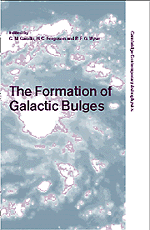Book contents
- Frontmatter
- Contents
- Preface
- Dedication: In Memory of Olin Eggen
- Part 1 Introduction
- Part 2 The Epoch of Bulge Formation
- Part 3 The Timescales of Bulge Formation
- Part 4 Physical Processes in Bulge Formation
- Part 5 Bulge Phenomenology
- Bulge-Disk Decomposition of Spiral Galaxies in the Near-Infrared
- The Triaxial Bulge of NGC 1371
- The Bulge-Disk Orthogonal Decoupling in Galaxies: NGC 4698 and NGC 4672
- The Kinematics and the Origin of the Ionized Gas in NGC 4036
- Optically Thin Thermal Plasma in the Galactic Bulge
- X-Ray Properties of Bulges
- The Host Galaxies of Radio-Loud AGN
- The Centers of Radio-Loud Early-Type Galaxies with HST
- Central UV Spikes in Two Galactic Spheroids
- Part 6 Conference Summary
- Index
The Host Galaxies of Radio-Loud AGN
from Part 5 - Bulge Phenomenology
Published online by Cambridge University Press: 10 November 2010
- Frontmatter
- Contents
- Preface
- Dedication: In Memory of Olin Eggen
- Part 1 Introduction
- Part 2 The Epoch of Bulge Formation
- Part 3 The Timescales of Bulge Formation
- Part 4 Physical Processes in Bulge Formation
- Part 5 Bulge Phenomenology
- Bulge-Disk Decomposition of Spiral Galaxies in the Near-Infrared
- The Triaxial Bulge of NGC 1371
- The Bulge-Disk Orthogonal Decoupling in Galaxies: NGC 4698 and NGC 4672
- The Kinematics and the Origin of the Ionized Gas in NGC 4036
- Optically Thin Thermal Plasma in the Galactic Bulge
- X-Ray Properties of Bulges
- The Host Galaxies of Radio-Loud AGN
- The Centers of Radio-Loud Early-Type Galaxies with HST
- Central UV Spikes in Two Galactic Spheroids
- Part 6 Conference Summary
- Index
Summary
AGN are known to lie in galaxies, and both galaxies and AGN evolve similarly over cosmic time (e.g., Silk & Rees 1998). This suggests a close connection between the nuclear phenomena associated with black holes and the formation and evolution of ordinary galaxies. The host galaxies of AGN are a direct probe of the AGN-galaxy connection. Among AGN, BL Lac objects are know to reside mostly, if not systematically, in elliptical galaxies. BL Lac can therefore probe (massive) spheroids to large redshifts. Results from an HST WFPC2 survey of ∼ 100 BL Lac objects are here presented.
Introduction: The Range of Radio-Loud AGN
While AGN are clearly unified through orientation (Antonucci 1993; Urry & Padovani 1995), important intrinsic differences remain. For example, extended radio lobes form only when the radio power exceeds a threshold that increases with galaxy luminosity (Ledlow & Owen 1996, Bicknell 1995). Powerful FRII radio galaxies (defined by their lobe morphologies; Fanaroff & Riley 1974) correspond to the most luminous quasars, while lower luminosity FRI radio galaxies correspond to BL Lac objects (Urry & Padovani 1995).
At any given redshift z, the full range of luminosity needs to be explored in host galaxy studies, to separate trends in host galaxy properties with nuclear AGN luminosity from a possible redshift dependence.
- Type
- Chapter
- Information
- The Formation of Galactic Bulges , pp. 183 - 186Publisher: Cambridge University PressPrint publication year: 2000

